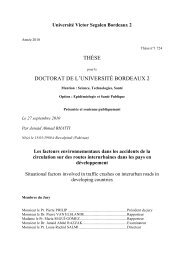Create successful ePaper yourself
Turn your PDF publications into a flip-book with our unique Google optimized e-Paper software.
1974 Loko et al.<br />
reason. The accuracy of liver biopsy to assess fibrosis has also<br />
been questioned in relation to sampling errors and intra- and<br />
inter-observer variability that may <strong>le</strong>ad to over- or understaging<br />
(14–16). These findings thus emphasize the need for<br />
accurate noninvasive methods to measure the degree of liver<br />
fibrosis. Several markers and models have been proposed<br />
over the past few years for the prediction of fibrosis in HCVmonoinfected<br />
patients, including the aspartate aminotransferase<br />
(AST) to plate<strong>le</strong>t ratio index (17), the Forns index<br />
(18), and plate<strong>le</strong>t count (19). However, very litt<strong>le</strong> information<br />
regarding the performance and utility of these tests in<br />
HIV-HCV-coinfected patients is availab<strong>le</strong>. Finally, FIB-4, a<br />
new index based on age, alanine aminotransferase (ALT),<br />
AST, and plate<strong>le</strong>ts has been specifically designed for predicting<br />
severe liver fibrosis in HIV-HCV-co-infected patients<br />
(20). Although this index has been very recently studied in<br />
HCV-monoinfected patients (21), it has not been validated<br />
independently in HIV-HCV- coinfected patients.<br />
The aim of our study was to evaluate the diagnostic performance<br />
of APRI, Forns index, FIB-4, and plate<strong>le</strong>t count for<br />
predicting liver fibrosis in HIV-HCV-coinfected patients.<br />
PATIENTS AND METHODS<br />
Patients<br />
This retrospective study included patients with HIV-HCV<br />
coinfection who were referred for liver biopsy prior to HCV<br />
antiviral therapy at the University Hospital of Bordeaux between<br />
January 1999 and January 2005. Inclusion criteria<br />
were: age above 18, positive serum antibodies to HCV by<br />
means of a second- or third-generation HCV enzyme-linked<br />
immunosorbent assay (Ortho Diagnostic, Raritan, NJ) and<br />
detectab<strong>le</strong> serum HCV RNA (Amplicor HCV, Roche Mo<strong>le</strong>cular<br />
Systems, P<strong>le</strong>asanton, CA). Exclusion criteria were: coinfection<br />
with hepatitis B, other known causes of liver disease,<br />
and alcohol intake of more than 50 g/day. A total of 200<br />
patients of the Aquitaine Cohort met those criteria.<br />
The ANRS CO3 Aquitaine Cohort, a prospective hospitalbased<br />
cohort of HIV-1-infected patients under routine clinical<br />
management, was initiated in 1987 in the Bordeaux University<br />
Hospital and four other public hospitals in the Aquitaine<br />
region, Southwestern France, by the Groupe d’Epidémiologie<br />
Clinique du SIDA en Aquitaine (GECSA) (22). All adult patients<br />
with HIV-1 infection confirmed by Western-blot testing,<br />
and who have given an informed consent are enrol<strong>le</strong>d in<br />
the cohort, whatever their clinical stage, gender or HIV transmission<br />
group. Additionally, information from at <strong>le</strong>ast one<br />
follow-up visit after the baseline assessment or known date<br />
of death has to be availab<strong>le</strong>. At each hospital contact, a standardized<br />
questionnaire including epidemiological, clinical,<br />
biological, and therapeutic data is fil<strong>le</strong>d in by clinicians and<br />
entered into the database. The schedu<strong>le</strong> of follow-up visits<br />
is based on clinical practice, and an active search of patients<br />
lost to follow-up is performed annually.<br />
Histological Assessment<br />
The liver biopsy specimen was fixed in 10% formalin,<br />
paraffin-embedded, and serially sectioned. Sections were<br />
stained with hematoxylin-eosin-safran, Masson’s trichrome,<br />
picrosirius red, and Gordon and Sweet’s stains. Biopsy samp<strong>le</strong>s<br />
were read by a sing<strong>le</strong> experienced pathologist (BLB)<br />
who was unaware of the clinical data of the patients, using<br />
the Metavir scoring system for fibrosis (23): F0 = no fibrosis;<br />
F1 = portal fibrosis without septa; F2 = portal fibrosis<br />
with rare septa; F3 = numerous septa without cirrhosis;<br />
F4 = cirrhosis.<br />
Noninvasive Indexes for Prediction of Fibrosis<br />
AST, ALT, gamma-GT, cho<strong>le</strong>sterol, and plate<strong>le</strong>t count, routinely<br />
determined for all patients, were availab<strong>le</strong> on the day<br />
of liver biopsy for 55% of patients, and within 1 month of the<br />
time of liver biopsy for 45%. APRI, Forns index, and FIB-4<br />
were calculated using the formula originally described (17,<br />
18, 20). The cutoffs used were those proposed in the original<br />
studies. For plate<strong>le</strong>t count, a cutoff of 150 10 9 /L (19) was<br />
used for predicting cirrhosis.<br />
Statistical Analysis<br />
Continuous variab<strong>le</strong>s were described by their mean and standard<br />
deviation (SD) or median and interquarti<strong>le</strong> range (IQR)<br />
and categorical variab<strong>le</strong>s by percentages. To evaluate the<br />
diagnostic performance of the different indexes, sensitivity<br />
(Se), specificity (Spe), positive predictive value (PPV), and<br />
negative predictive value (NPV) were calculated, using cutoffs<br />
previously described for each index (17, 18, 20). The<br />
overall diagnostic performance of scores was evaluated by<br />
area under the receiver operating characteristic curves (AU-<br />
ROC). The percentage of patients correctly identified (PCI)<br />
was also estimated for each index. AUROCs were compared<br />
according to the procedure proposed by Han<strong>le</strong>y and McNeil<br />
(24). Statistical analyses were performed using Stata Statistical<br />
software, version 9.2 (Stata Corporation, Col<strong>le</strong>ge Station,<br />
TX).<br />
RESULTS<br />
Study Population<br />
The main characteristics of the 200 HIV-HCV-coinfected patients<br />
included are presented in Tab<strong>le</strong> 1. The mean age was<br />
39.8 ± 6.3 years and 67% of patients were ma<strong>le</strong>. Their median<br />
CD4 cell count was 500 (78–1,644) cell/µL. Most patients<br />
(87%) were receiving highly active antiretroviral therapy<br />
(HAART) at the time of noninvasive evaluation of liver<br />
fibrosis. The mean plate<strong>le</strong>t count did not differ between patients<br />
receiving HAART (N = 174) or not (N = 26): 191 ± 68<br />
vs 171 ± 55 10 9 /L, respectively (P = NS). Significant fibrosis<br />
(F ≥ 2) was present in 157 patients (78.5%) and cirrhosis in<br />
40 (20%). The mean liver biopsy <strong>le</strong>ngth was 15.7 ± 7.5 mm.<br />
Biopsy <strong>le</strong>ngth was greater than 10 mm in 154 patients (81%),<br />
and greater than 15 mm in 89 (46.8%) (Tab<strong>le</strong> 2).
















